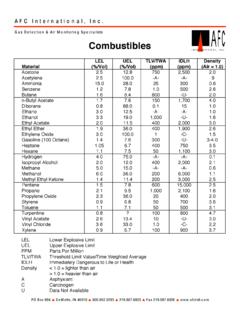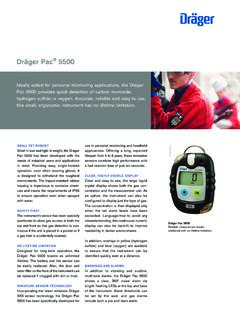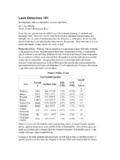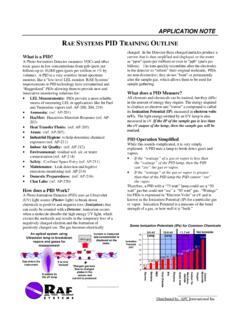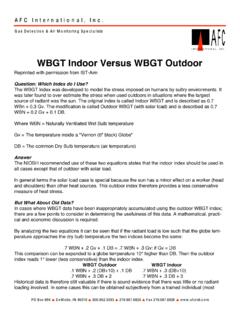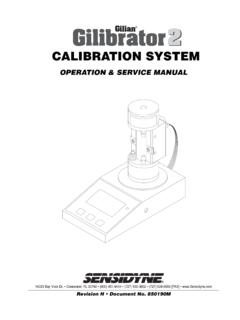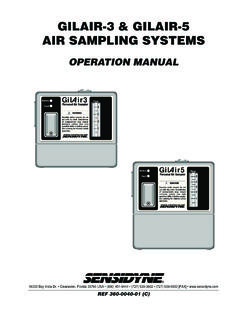Transcription of Comparison Between a Passive Organic Vapor …
1 PO Box 894 DeMotte, IN46310 Fax w w w . a f c i n t l . c o mAFC Intern ational, Detection &Air Monitoring SpecialistsComparison Between a PassiveOrganic Vapor Monitor (OVM)and a Charcoal Tube for MonitoringBenzene, Ethyl Benzene, Toluene and XyleneBy: G. M. Mihaylov, K. S. Kirollos and K. B. Chapman, K&M Environmental, to increased awareness of the toxicity of Organic substances, government organization, such asthe Occupational Safety and Health Administration (OSHA) and the National Institute forOccupational Safety and Health (NIOSH), have continually decreased the permissible exposure limitsof many Organic substances. For example, in the last ten years, the permissible exposure limit forbenzene has been lowered from 10 to ppm. This has lead to an increased demand for samplingmethods and devices capable of measuring these low concentrations. Although Passive diffusivemethods have been used for more than a decade, there is still hesitation about their performance ascompared to the tube/pump Comparison study was conducted Between the traditional active charcoal/pump method and a diffu-sive Organic Vapor monitor (OVM).
2 Four substances were evaluated: benzene, toluene, ethyl ben-zene and To prove the ability of a Passive diffusive OVM to serve as a simple, accurate , cost effectivealternative to the tube/pump method. The OVM avoids the following drawbacks of thetube/pump method: The tube/pump method requires highly trained personnel to (1) maintain and calibrate air sampling pumps and (2) prepare for testing. In many work situations, wearing a sampling pump and connection tubing impairs worker performance. The average cost per tube/pump sample is high2. To find an alternative device capable of accurately measuring low recent years, NIOSH acknowledged the use of Passive Organic monitors as an alternative to thetube/pump method with the development of NIOSH Method 40001. Several Passive monitors aredescribed in this method. To measure low concentrations, a Passive monitor should posses high sam-pling rates comparable to the active method. The GC response of three OVM's exposed simultane-ously to benzene is depicted in Figure 1: BenzeneExperimentalMaterials:Standard coconut charcoal tubes (100 mg front and 50 mg back section) were usedthroughout the study in conjunction with the gilian sampling pump Model LFS-113.
3 TraceAir organicvapor monitors were used as a representative of diffusive samplers. Benzene, toluene, ethyl benzeneand xylene vapors were generated in a dynamic Vapor generating system; a schematic diagram isdepicted in figure 2. Vapor concentrations were verified with an independent method using on-lineSRI Model 8610 GC. Significant data was considered when the generated and verified concentra-tions were within 5% In the laboratory testing, TraceAir OVM-2 monitors were used to ensure breakthrough did not occur. Five badges were used in each experiment. Testing was conducted at 80% RH and 25 C. The only influence that water Vapor has on the TraceAir badges is that is competes for active sites on the charcoal * , it affects the capacity). Therefore, performance parameters measured at 80% RH will be valid or superior to any humidity conditions below 80% RH (Figures 3 to 7). Field testing was setup to monitor for benzene vapors. TraceAir OVM-1 monitors and standard charcoal tubes were exposed simultaneously.
4 Thirty-four pairs of the monitoring devices were used in the procedure. sampling times varied from 13 to 690 minutes, and concentrations ranged from to ppm (figure 8)Figure 3 Figure 4 Figure 5 Figure 6 Figure 7 Figure 8 ConclusionOVMTubeCompoundBiasOverall AccuracyBiasOverall Woebkenberg, M. L.,: Toluene ( Passive ) NIOSH Method 4000. NIOSH Manual of Analytical Methods (NMAM) Fourth Edition, Aug. 15, Cassinelli, M., Hull, R., Crable, J. and Teass, A.: Protocol for Evaluation of Passive Monitors. National Institute for Occupational Safety and Health, Nelson, G. O.: Controlled Test Atmospheres. Ann Arbor Science, Michigan (1982).4. Woodfin, W.: Gas and Vapor Generating Systems for Laboratories. U. S. Department of Health and Human Services, Ohio (1984).5. Duncan, A. : Quality Control and Industrial Statistics. Richard D. Irwin, Illinois (1953).6. Lautenberger, W. , Kring, E. , and Morello, J. : A New Personal Badge Monitor for Organic Vapor .
5 Am. Ind. Hyg. Assoc. J. 41:737-747 (1980).7. TraceAir System, Laboratory and Field Validation Report. Aromatics, gilian Environmental, Corp. (Feb. 1993).8. TraceAir System, Technical Reference Guide, gilian Environmental, Corp. (1993).AcknowledgmentsK&M Environmental and the authors gratefully acknowledge the efforts and dedications of Mrs. EmilyMcCloughery and Mrs. Melanie Mason for accomplishing this work.
